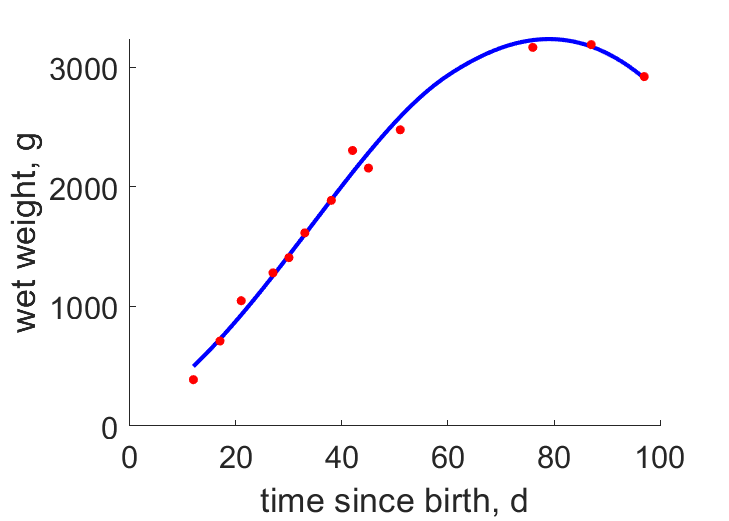Predictions & Data for this entry
| Model: std | climate: MA, MB | migrate: Ms | phylum: |
| COMPLETE = 2.5 | ecozone: MAE, MPW | food: biCvf | class: |
| MRE = 0.025 | habitat: 0iMc | gender: Dg | order: |
| SMSE = 0.003 | embryo: Tncfm | reprod: O | family: |
Zero-variate data
| Data | Observed | Predicted | (RE) | Unit | Description | Reference |
|---|---|---|---|---|---|---|
| ab | 44 | 44.61 | (0.01385) | d | age at birth | avibase |
| tx | 97 | 97.07 | (0.0006798) | d | time since birth at fledging | avibase |
| tp | 291 | 285.6 | (0.01873) | d | time since birth at puberty | guess |
| tR | 1278 | 1278 | ( 0) | d | time since birth at 1st brood | avibase |
| am | 2920 | 2908 | (0.004231) | d | life span | avibase |
| Ww0 | 105 | 90.25 | (0.1404) | g | initial wet weight | avibase |
| Wwb | 70 | 71.38 | (0.01971) | g | wet weight at birth | Wiki |
| Wwi | 2665 | 2697 | (0.01195) | g | ultimate wet weight | avibase |
| Ri | 0.00274 | 0.002729 | (0.004072) | #/d | maximum reprod rate | avibase |
Uni- and bivariate data
| Data | Figure | Independent variable | Dependent variable | (RE) | Reference |
|---|---|---|---|---|---|
| tW |  | time since birth | wet weight | (0.03341) | Jarv1974 |
Pseudo-data at Tref = 20°C
| Data | Generalised animal | Morus capensis | Unit | Description |
|---|---|---|---|---|
| v | 0.02 | 0.02299 | cm/d | energy conductance |
| p_M | 18 | 499.3 | J/d.cm^3 | vol-spec som maint |
| k_J | 0.002 | 0.02038 | 1/d | maturity maint rate coefficient |
| k | 0.3 | 0.2988 | - | maintenance ratio |
| kap | 0.8 | 0.9722 | - | allocation fraction to soma |
| kap_G | 0.8 | 0.8005 | - | growth efficiency |
| kap_R | 0.95 | 0.95 | - | reproduction efficiency |
Discussion
- Feeding is reduced towards end of nestling period
- Long tp cannot be captured by std model
- mod_1: v is reduced
- mod_1: Pseudo-data point k is used, rather than k_J; Data set tp and parameter t_R are added, the latter replacing clutch interval t_N. Postnatal T is based on PrinPres1991, see get_T_Aves. See further the revision page, theme puberty
Acknowledgment
- The creation of this entry was supported by the Norwegian Science Council (NFR 255295)
Bibliography